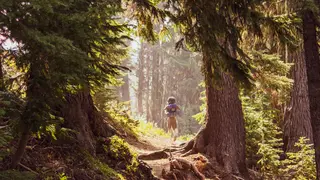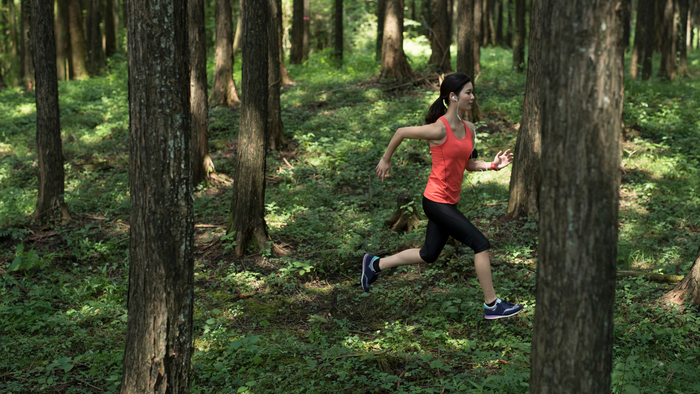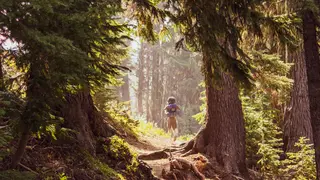
The power of the forest
The significance of forests to the health of the planet and our well-being cannot be overstated. Beyond the many items essential to society like wood and paper products, forests provide us with oxygen and mitigate the effects of climate change by absorbing carbon dioxide. They supply up to 75% of the world’s accessible fresh water, provide essential food and natural medicines, lower air temperature, stabilize soil to help prevent erosion, and are home to 80 percent of the world’s plants and animals, according to the Food and Agriculture Organization of the United Nations.
Last, but certainly not least, forests bring us joy in so many ways, from myriad recreational activities like hiking, camping, picnicking and birdwatching to something as simple as just listening to the peaceful sound of the wind in the trees and connecting to nature through forest bathing.
Forest bathing: An ancient idea for the modern world
While the idea of spending time in nature is obviously not new, reconnecting to nature as a healing practice first took root in Japan in the 1980s and was called shinrin-yoku which translates as “forest bathing” or “taking in the forest atmosphere.” At that time, doctors and researchers realized that modern-day city life was taking its toll on a population spending most of its time working indoors, causing depression, anxiety and other health problems.
As the hustle and bustle of daily life has only continued to increase, forest bathing has become a part of preventative healthcare in many countries around the world and, in the last several years, has quickly and quietly gained steam in the United States.
A significant amount of research has proven the remarkable health benefits that come from spending time in nature. A study published in the International Journal of Environmental Research and Public Health suggests that “walking as little as 15 minutes in a forest can improve one’s mood and relieve stress and anxiety.” The practice of forest bathing has a positive effect mentally, physically, emotionally and spiritually, and can increase energy levels, boost the immune system and healthy antioxidants in the body, increase cortisone levels, lower blood pressure, and reduce stress. Many of these health benefits are due to phytoncides—the volatile organic compounds (VOCs) or “essential oils”—emitted by trees. The visual stimulation, smells and other sensory elements of the forest add to the therapeutic value of forest bathing.

What exactly is forest bathing?
Forest bathing is a sensory experience and a chance for a digital detox, so leave your phone at home. It is about mindfully immersing yourself in the nature around you. Anyone can practice it anytime, and almost anywhere—and although a private or public forest is ideal, anywhere you can see trees will work, including an urban park or even your own backyard. It can also be done on your own or with one of over 2,000 certified guides across the United States.
Although there are many benefits to using a certified guide, for a quick reboot of your neurological and physical systems on your own, Tamberly Conway, founder and CEO of Conservation Conexions, recommends finding a quiet place in safe surroundings where you can choose a “sit spot”—a place you can comfortably sit for 20 minutes. Close your eyes, breathe deeply and slowly move yourself through your own senses one by one, consciously thinking about the smells, the tastes and the sounds.
For a more complete and immersive forest therapy experience, a certified guide will facilitate slow, professionally guided, meditative walks that generally last two to three hours. Guides will provide sequenced “invitations” along the way to help participants attune to the touch, sights, smells, tastes, and sounds of the forest. As described by William Watson, a forest therapy practitioner, a guide can help people to notice things they may otherwise miss and “cultivate the senses that are already natural to us.” Search online to find a certified guide near you, or visit the Association of Nature and Forest Therapy’s website at anft.earth.
When we care for our forests, they help care for us
To ensure that we have thriving, vibrant forests to enjoy, it is essential that we care for them just as they care for us. The paper industry is part of a larger movement to grow and protect forests and the habitats around them, made possible through close collaboration with privately owned American forests, which are among the most sustainably managed in the world.
In the United States, more than half of forestlands are privately owned and managed by about 11 million forest owners across the country. Many of the forests are small, family-owned tracts in rural communities. The landowners spend years carefully cultivating and stewarding the forest, harvesting only what is needed and continually planting to ensure regrowth. These forests supply more than 90% of the wood in the U.S. that makes paper and wood products, according to the American Forest & Paper Association. A vibrant paper industry enables these landowners to responsibly manage their forestland. Without the income from sustainably grown wood, many landowners would develop their land for other use, turning it into farmland or real estate development.
To ensure that our forests are sustainably stewarded and protected, many forestland owners adhere to independent, internationally recognized sustainable forestry certification programs that account for habitat, biodiversity, water and soil quality, and other factors in planning for the long-term health of the land.
Protecting our forests for the future
The efforts by the paper industry and private forest owners have resulted in nearly twice as much wood being grown each year in the United States as being harvested. According to the U.S. Forest Service, one-third of the country is forested, totaling 766 million acres. Approximately 3.5 million trees are planted daily, totaling more than one billion trees a year. And, in the last 30 years, forested areas have increased by nearly 33 million acres—the size of 2,275 football fields of forest growth every day.
Through collaboration with private landowners, the paper industry is committed to safeguarding and growing our treasured forests through sustainable practices so that we can enjoy them now and for generations to come.




